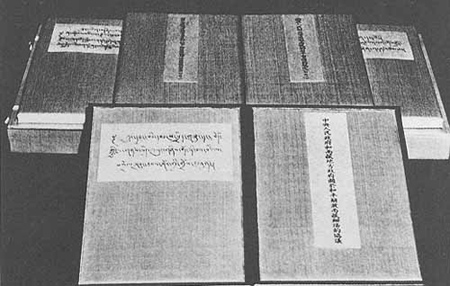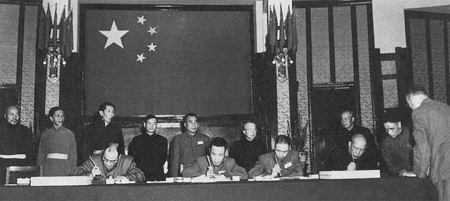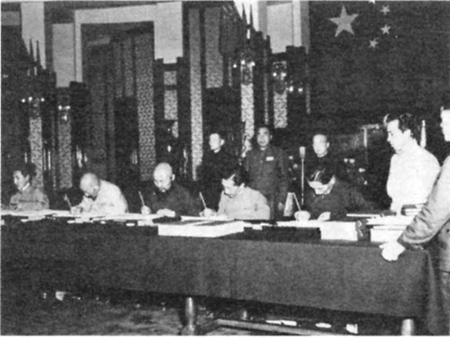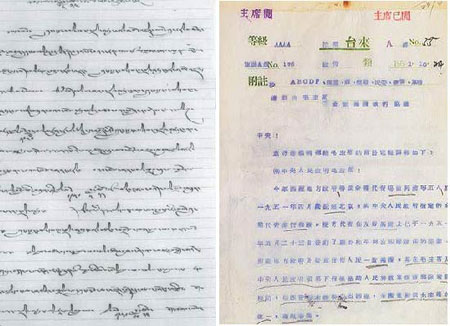17-Article Agreement's validity beyond doubt
May 23, 2013 was the 62nd anniversary of the signing of the Agreement between the central government and the local government of Tibet, also known as the "17-Article Agreement" in Beijing, May 23, 1951, marking Tibet’s peaceful liberation.
However, the 14th Dalai Lama on many occasions repudiated the validity of the agreement although he himself accepted it after it was signed. At this particular moment, it is necessary to review the historical facts and confirm its validity.
The negotiations
The Dalai Lama had on many occasions challenged the "17-Article Agreement" as having been "thrust upon the Tibetan government and people by the threat of arms".
As a matter of fact, the forming of the agreement is always based on consultation instead of military "duress".
Before the negotiations, Li Weihan, chief representative of the central government consulted Ngapoi Ngawang Jigmei, chief representative of the Tibet local government sent by the Dalai Lama on the time, venue and method of the negotiation, sources from Xinhua.
And according to China’s White Paper released in 2011, the central government had never given up its efforts for the peaceful liberation of Tibet. Even during the Chamdo Battle, late Chairman Mao Zedong urged that "the Tibetan delegation should come to Beijing as soon as possible” for negotiations.
Yet it was true that the negotiations didn't go smoothly, but all the disputable issues were resolved through consultations.
First, the Tibet local government refused to allow the Chinese People's Liberation Army's (PLA) to march into Tibet.
In this regard, the representatives of the central government held that the PLA had every reason to garrison Tibet for national defense, that the troops to be stationed in Tibet did not need financing from the local government of Tibet, hence would not increase Tibet's financial burden.
Ngapoi Nagwang Jigmei later wrote in his article "Great Progress in Tibet's Development" published on Dec.26, 1990,"Marching into Tibet for national defense does not mean in the least interfering in Tibet's internal affairs. The reason why the PLA troops should be stationed in Tibet is that the current world situation is turbulent and unstable."
Second, the Tibetan representatives were worried that the existing system in Tibet would be transformed. The representatives of the central government promised not to change the existing system in Tibet. Even if changes had to be made, they were subject to the decision by the local government of Tibet and the Tibetan people.
Third, the Tibet local government found it hard to accept that the Panchen Lama's position and authority written into the Agreement, which was the most controversial issue during the entire process of negotiations.
According to Ngapoi's recollection in the documentary "Fifty Years of Tibet" produced in May 2001: "One of the central representatives Sun Zhiyuan then proposed that they maintain the same status and powers when the 13th Dalai Lama and the 9th Panchen Lama were on good terms", which "was acceptable to us."
Tubdain Dainda, the monk official representative recounted the details in his article "Tibetan Cultural and Historical Data Anthology" published in 1982:
"During the negotiations, we Tibetan representatives accepted 10 articles proposed by the central government. Then we put forward a nine-point proposal. The central government adopted the correct parts and made patient explanations of the irrational parts. As a monk official sent by Yig-tshang (the secretariat of the local government of Tibet),I made proposals mostly concerning the religious belief and revenues of monasteries. Most of my proposals were adopted by the central government," sources from Xinhua.
After 25 days of tough negotiations, a consensus was reached. On May 23, 1951, the representatives of the Central People's Government and the local government of Tibet officially signed the 17-Article Agreement in Beijing.
Ngapoi Ngawang Jigmei in his article entitled "Return to the warm embrace of the Motherland" published in 1981 wrote: "We held earnest and friendly negotiations on the basis of equality and consultation," "and correctly resolved all complicated issues according to the policy of the Chinese Communist Party on resolving issues related to domestic ethnic groups and in line with the special conditions in Tibet," reported by Xinhua on March 17, 2009.
Besides, the clarity of the signing process was also verified. Ngapoi also wrote: "On May 23, we signed the 17-Article Agreement with the central delegation and made it public to the whole world. Meanwhile, we cabled to the Dalai Lama and Gaxag about the specific terms of the agreement."

The "17-Article" Agreement [File photo/Xinhua]

The "17-Article Agreement" was signed in Beijing on May 23, 1951.[File photo/Xinhua]

Representatives of Tibet local government signed the "17-Article Agreement" on May 23, 1951. [File photo/Xinhua]
The Dalai Lama's response
In June 1951, entrusted by the central government, the representative Zhang Jingwu sent Chairman Mao's letter to the Dalai Lama.
In October, the Dalai Lama wired to Beijing to express his support to the "17-Article Agreement."

Picture shows the cable sent by the 14th Dalai Lama to Chairman Mao Zedong, in which Dalai expressed his support to the Agreement on the Peaceful Liberation of Tibet.[File Photo/Xinhua]
The Dalai Lama wrote to Chairman Mao Zedong on Oct.2, 1951: "The local government of Tibet as well as the Tibetan monks and laymen unanimously support this agreement, and under the leadership of Chairman Mao and the Central People's Government, will actively assist the People's Liberation Army troops in marching into Tibet, in order to consolidate national defense, drive imperialist forces out of Tibet and safeguard the territorial and sovereignty integrity of the motherland."
However, in 1959 it was the same Dalai Lama who tore up the Agreement and fled abroad. On his way to India on March 26 1959, the Dalai Lama repudiated the "17-point Agreement" as having been "thrust upon Tibetan Government and people by the threat of arms".
Canadian scholar A. Tom Grunfeld wrote in his book titled "The Making of Modern Tibet":"If this accusation is true, why didn't the Dalai Lama mention it in his letter? And, if this Agreement was imposed on Tibetans, why did the Dalai Lama and almost all the Tibetan nobles return to Lhasa and work with the Han people together?"
Sthe Dalai Lama broke his promise, disappointed the central government for its trust on him and betrayed his motherland. Then what is the credibility of him as a "Buddhist savior"?
The Western interference
From the very beginning, the betrayal of the Tibet local government from China's central government was all instigated by the Western forces, attempting to seize the territory of Tibet. In fact, the "Tibet issue" was originated from the Western imperialism.
In 1949, American Lowell Thomas entered Tibet via India in the guise of a radio commentator and kept in frequent touch with Tibet's pro-imperialist upper class. After returning to the United States, he released an article on New York Times, asking the U.S. to help Tibetans with guerrilla warfare, sources from Xinhua.
In January 1950, British Fox, a radio expert employed by Gaxag, wrote to the commander of the Tibetan Army, advising how to collect information concerning PLA and destroy the hubs to prevent the PLA troops from marching into Tibet.
Although urged by the central government, the local government of Tibet didn't send a delegation to Beijing for negotiations, but send pro-imperialist representatives to beg Western forces to interfere in China's unification. Gaxag's regent Tatra even cabled to United Press International of America, asking for its support for "Tibet independence".
In this sense, without the backup of the Western imperialists, the debate about the validity of the "17-Article Agreement" would never have incurred. It was those Western forces who schemed to disrupt China's unity and stability and obstruct China's rise as a new power in the world under the leadership of the Chinese Communist Party. The signing of the "17-Article Agreement" was, therefore, a very significant historical event, which freed Tibetan people from foreign enslavement and returned to the big family of the Chinese nation.
Furthermore, the vilification of the Dalai Lama and his followers toward the signing of the "17-Article Agreement" only challenged his own credibility, and exposed their wishful thinking of separating Tibet from China and resuming their theocratic rule, which has been abandoned by all over the world.
Your Comment
Name E-mailRelated News
-
;
-
-
"17-Article Agreement" reflects religious freedom in Tibet
May 23 marked the 64th anniversary of the peaceful liberation of Tibet.On May 23, 1951 the central government and the Tibetan local government signed the "17-Article Agreement".
-
-
-
Article says inclusive development keynote of Tibet's human rights progress
The inclusive development in China's Tibet Autonomous Region is the prime keynote of the human rights progress in the remote region, says a Chinese scholar.
-
-
-
Full Text of the 17-Article Agreement
Full text of the Agreement of the Central People's Government and the Local Government of Tibet on Measures for the Peaceful Liberation of Tibet, or the 17th-Article Agreement signed in Beijing on May 23, 1951.
-
Based in Lhasa, Tibet Vista is a Tibet travel agency that specialized in Tibet permit, and Tibet tours for both private and group travelers at a local price!
•4 Days Lhasa City Group Tour from USD 460 •8 Days Everest Base Camp Group Tour from USD 850 •15 Days Mt.Kailash Group Tour from USD 1780 •2016 Tibet Train Tours from Beijing, Shanghai, Chengdu, Xining,etc










